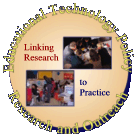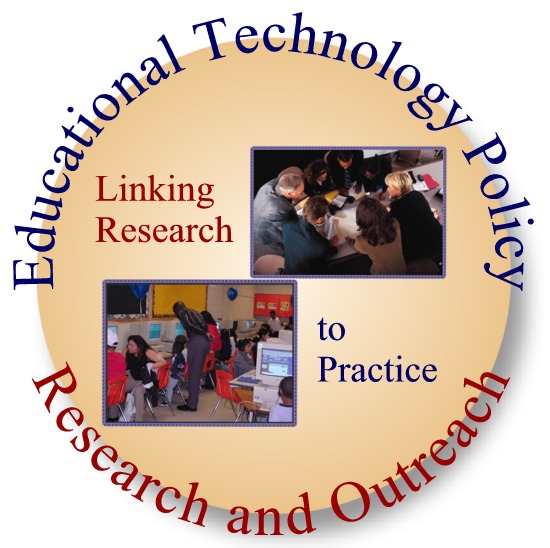 |
|
||||||||











History of Educational Technology within the College of Education at the University of MarylandThe Center: Past/Present/FutureThe Educational Technology Center in the College of Education was originally created in 1958 to provide new technologies for classroom instruction. The goal at that time was to place a transparency projector in every classroom in the building and to train preservice teachers to use this resource in their teaching. Over the ensuing forty years, the Center has provided a variety of multimedia resources in support of College activities. While the Educational Technology Center was a place where faculty could check-out equipment to enhance instruction, it also at one time housed a TV studio for creating video programs and facilities for developing slide-tape shows. In a study of technology use in teacher education programs released in October, 1997, by the American Association of Colleges for Teacher Education (AACTE), it was reported that though faculty frequently used email for communicating with colleagues, they only occasionally used technology in teaching their classes. Moreover, one of the most common technologies they employed was a VCR, which was frequently one of the few technologies readily available in their classroom. As the Office of Technology Assessment (1995) found in its comprehensive study of technology utilization in teacher education, students continued to take courses where they learned various technology tools but rarely saw their instructors model its use and seldom had opportunities for developing technology-enriched lessons that they could implement during student teaching. AACTE's report indicated that the majority of teacher education programs produced teachers that were ill-prepared to infuse information technology into the K-12 curriculum. School districts that hired these newly-minted teachers would often have to offer expensive professional development opportunities to enhance the skills and knowledge of these individuals. As an outcome of this report, in 1997, AACTE, NCATE (National Council for the Accreditation of Teacher Education), the City University of New York and the University of Maryland (through involvement in the Northeast Regional Technology in Education Consortium--NetTech), organized two Deans' Forums on Technology in Teacher Education which were held in Washington, DC, and College Park. These were designed to assist teacher education programs in the Northeast in enhancing infusion of information technology in the curriculum. A total of 43 teacher education programs participated in this initiative out of approximately 120 in the region. The discussions occurring at these Deans' Forums made it clear to those in attendance that developing a plan for enhancing technology utilization was a critical first step. In 1997 the Center's name was changed to the Center for Learning and Educational Technology (CLET) to reflect its expanding mission. The technology services provided by the Center included:
Dean Willis Hawley in April, 1998, appointed an Advisory Committee for the Center for Learning and Educational Technology for the purpose of developing a plan to enhance the use of technology in the College of Education at the University of Maryland. The Advisory Committee discussed various options for increasing the use of technology in the College and recommended to the Dean of the College that Stan Bennett be appointed as the full-time Director of the Center for Learning and Educational Technology. One of his first actions was to convene a special meeting of members of the Advisory Committee and staff from the Center to begin discussions of a vision and blueprint for enhancing technology utilization in the College of Education. Four Task Forces were subsequently formed: Teaching with Technology; Technology and Research; Technology Outreach; and Technology Services. Faculty and staff from across the College were invited to join these committees. During the period from August through November, 1998, Task Forces engaged in ongoing discussions and wrote a report describing a suggested mission statement, a set of initiatives that should be undertaken, how these initiatives should be implemented and suggestions for evaluating the outcomes of these efforts. Subsequently, these four reports formed the basis for strategic plans in each of the four areas of teaching, research, outreach and technology services. Later in 1998, Kathleen Fulton was hired as Associate Director, and in 1999, Dan Thoms was brought on board as manger of staff development and school programs to assist in the training of faculty and development of partnerships with the K-12 community. During this time strong partnerships were formed between CLET, Queen Anne's County Public Schools and Baltimore City Public School System, as well as the first university connection with Marco Polo and other inservice training opportunities throughout the state. In July of 1999, Edna Szymanski became Dean of the College of Education. Kathleen Fulton left to serve as the Project Director for the congressional Web-based Education Commission (www.webcommission.org). Later in 2000, CLET was reorganized to better fit the needs of both the college and the greater educational community. Two major units were formed. Educational Technology Services (ETS) focuses on staff development for skills based programs for faculty and staff, networks, computer resources, and web sites for the college. Educational Technology Outreach (ETO) was created to serve the professional development needs of the educational community, and with Dan Thoms' departure for private industry, Davina Pruitt-Mentle joined Educational Technology Outreach in July 2000 as Associate Director. In the Spring of 2002, Stan Bennett "semi-retired" and ETO was placed under the Outreach and Research division of the Dean's office and Ms. Pruitt-Mentle became Director. ETO's works in collaboration with ETS, the Office of Information Technology (OIT), faculty within the six College of Education departments, graduate assistants, Office of Continuing Education, and other units across campus.
|

